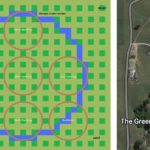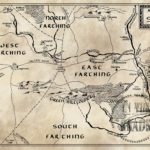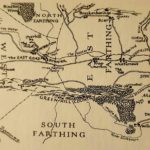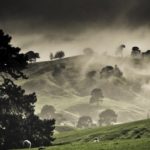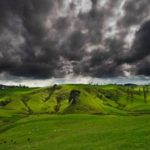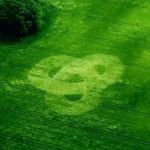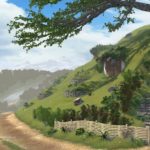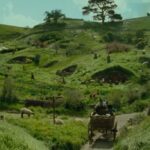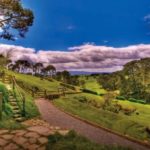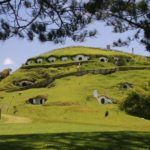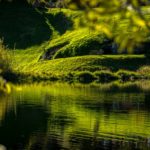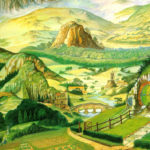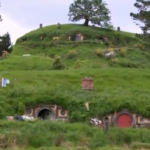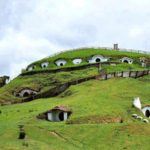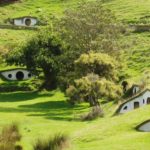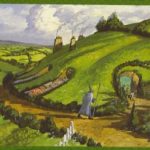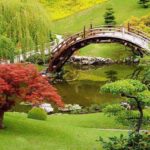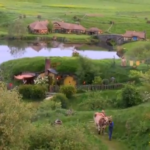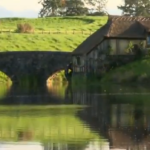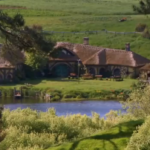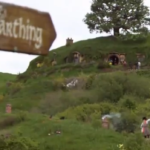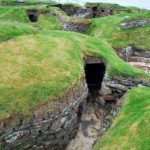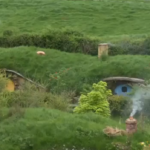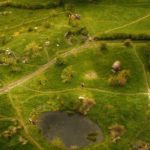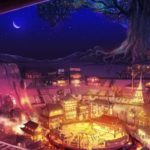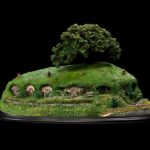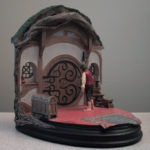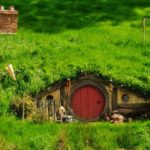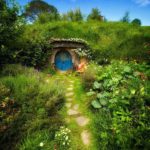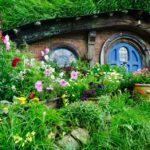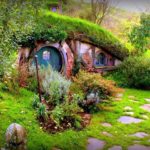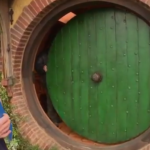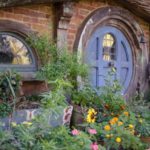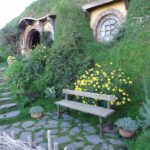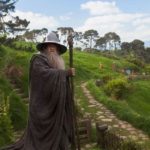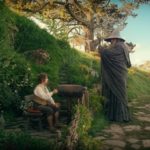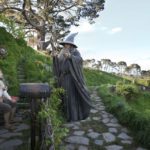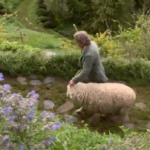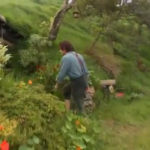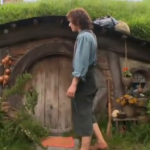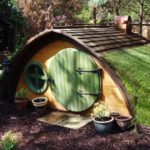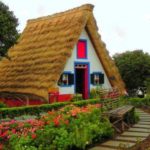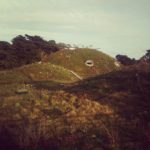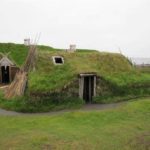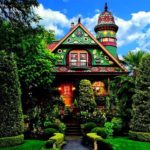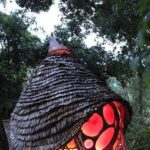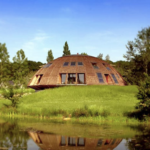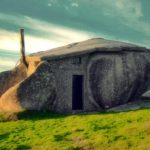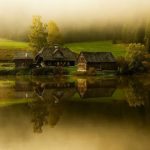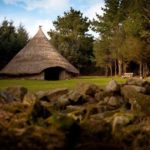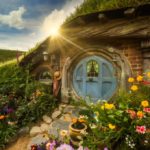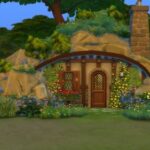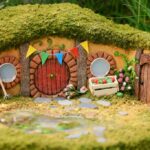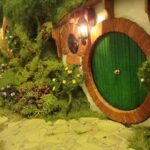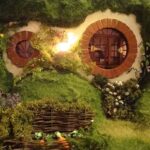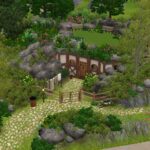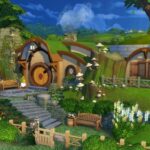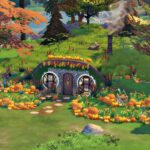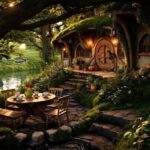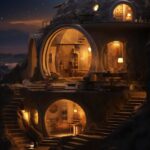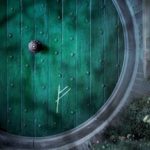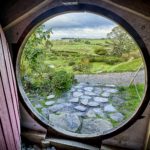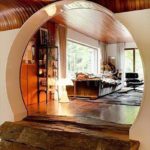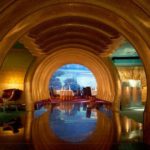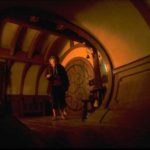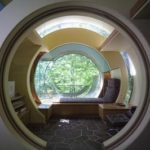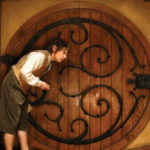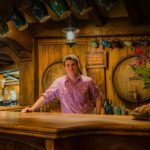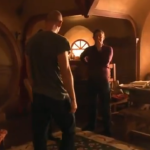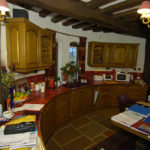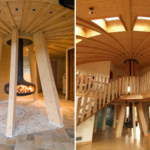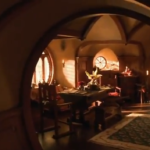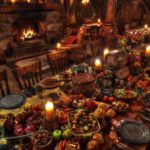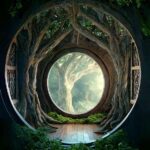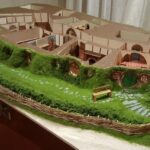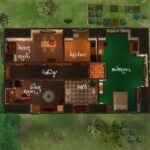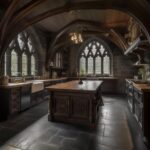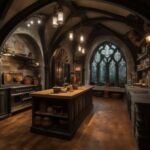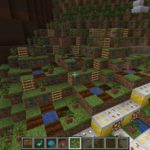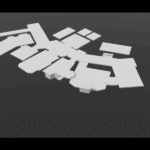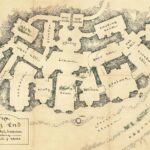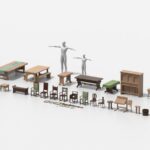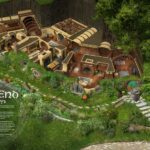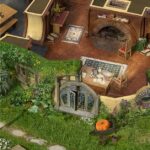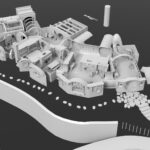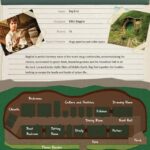Originally a clone of the Shire called Hobbiton, built in New Zealand for the Lord of the Rings and Hobbit films, this one has now expanded.
–
Table of Contents:
- Introduction
- Dimensions & Layout
- Special Features
- Shires Directory
- Population Over Time
- Novels Excerpt
- Location & Overall (Images Begin)
- Original Maps
- Exterior/Area
- Town
- Models
- Single Residence, Exterior
- Interior
- Slope of the Shires in Inisfree based on the Minecraft Model
- 2022 Update: Untold History
- 2023 Update: Bilbo Baggin’s Home
–
Introduction:
‘Shire’ is a term in Inisfree which may also mean ‘village’ or ‘small town’ (though we also say “vil’s”). Originally, there was only one Shire in Inisfree, and it was designed to closely resemble the town of the same name from the Lord of the Rings and The Hobbit trilogies. Today, there are several Shire-like neighborhoods (often called ‘hoods’) in Inisfree, from the larger and more fortified Kathedrom, to the more widely dispersed and individually hidden tree-house-mansions of the Cabins ‘Hood.
–
Dimensions & Layout:
The original Shire of Inisfree is 1,518 feet in diameter; just over a quarter of a mile. Its residences are in the style of ‘Hobbit holes’, neatly tucked away into the rolling foot-hills where Inisfree’s central mountain base finishes flattening out toward the steep walls of its dense urban area, Sotu. Long lodges, a farmer’s market, and other festivities gathering-areas complement this quaint and storied village, and some of its ‘Hobbit holes’ include basement levels reaching down into the Inisfreean earth more than a few stories.
For comparison, Hobbiton (the set of the shire featured in the famous movies) measures ~500′ across. This means in our 1,518′-diameter Shire(s) area, we have room for all 8 shires mentioned in the Tolkien books (though the overall nation-like Shire from that saga included some 20,000 square miles of many more such villages). Five shires fit neatly within that circular area, and the remaining three are nestled in and somewhat ‘spilling over’ across its border, each shire some 20-50′ apart from the neighboring shires, all connected by foot-paths barely big enough for a cart.
There are 44 Hobbit-holes (homes) in the Shire movie-set in New Zealand. We have ~125 Hobbit-holes in each of our shires here in Inisfree. They are still spread out about the same amount; they are about as close as normal houses or townhouses in an Outlands neighborhood would be.
Being on the slope of our central mountain near where its base is foothills blending in with the surrounding flat/meadows terrain, one our shires is higher up that slope than the others, and one is lower, with the rest being somewhere in between.
1,518′-diameter area (1,810,000 sq.ft.)
8 shires (226,250 sq.ft. per shire)
125 Hobbit holes in each shire (1,810 sq.ft. per Hobbit hole; 42’^2)
…
Bilbo’s house (perhaps the largest Hobbit hole in the stories) was 4,500 sq.ft. = 67’^2
…
Avg. house is 2,500 sq.ft.; 50’^2 (or 2 1,250 sq.ft. floors; 35’^2
Avg. apartment is 800 to 1,000 sq.ft. (28’^2 to 31’^2)
…
In the 1,518′-diameter Shires area we allotted, we have room for 1,000 dwellings, each twice the size of a normal apartment, and 3/4 the size of an average house.
…
Keep in mind that they are entirely under/in hills, only their front door patio showing; all their sides can touch underground, so there is no need for fences or greenbelts.
–
Special Features:
This is, perhaps, the only place in all of Inisfree where everything is built to fit humanoid beings not quite so tall as humans. Like the homes and other makings of Hobbits, everything here is closer to the size one would find in the children’s section of any store, or in a Toys “R” Us. This is, of course, intended not for Hobbits, but members of our Fairy population, as well as some of the shorter/female Elves, such as some Drow, as there are no Hobbits in Inisfree.
–
Shires Directory:
These villages in Inisfree are built to be identical to their descriptions from the storied books:
- Shire 1: Westfarthing (includes White Downs, Little Delving village, Waymoot, Tuckborough, Bywater village, Rushock Bog, Hobbiton, and Bag End tunnel)
- Shire 2: Eastfarthing (includes Frogmorton town, Whitfurrows town, the Marish (marshy farmland) and its town; Stock, Woody End, and The Yale )
- Shire 3: Southfarthing (includes Green Hill Country, Longbottom (meaning “long valley”), Overbourne Marshes, and Sarn Ford)
- Shire 4: Northfarthing (least populous shire, near the Snowdunes)
- Shire 5: Buckland (includes its main town; Bucklebury, Buckleberry Ferry, Haysend village, and Crickhollow hamlet)
- Shire 6: Westmarch (including Undertowers)
- Shire 7: Tookland
- Shire 8: Gamwich
We kept their orientation as close as possible to how they were arranged relative each other on the surviving map, with Gamwich and Tookland within the region-like Westfarthing. So far, they are distinct from one another only in, besides their locations, name. While the four ‘farthings were more like counties or even small states, they in Inisfree are represented by single shires/villages.
–
Population Over Time:
~10 human-sized people can be comfortably housed in any of the Hobbit-holes of our shires.
Roughly 1 more person made this neighborhood/area his/her home (or at least their 2nd/vacation home) every ~2 years from 2013 to 23000 A.D..
- 2013: the first guest or resident here
- 2022: ~5 living in this neighborhood this year
- ~23000 A.D. and beyond: ~10,000 at capacity
–
Novels Excerpt:
Once she had time to explore the hospital, so she’d know where it is, how it functioned, and where to find each wing and department in it, if ever she or someone she knew in Inisfree might need that information, Auz walked with her back outside, and waved to their drivers to take the limousine back to where it might be needed; he and Lucifera could proceed over the flowered foothills on their own to the next destination. Their driver and co-driver smiled and waved, understanding, then got back in the long white vehicle and skillfully drove it away on the Glowing Art Highway.
Walking across a few low and gently-rolling hills, with a tall stand-alone mini-mountain shaped in Auz’s chest-up likeness on their left, he showed her where she could find Inisfree’s own version of the storied Shire from Lord of the Rings and The Hobbit trilogies. As they crested the last hill between the hospital and that new shire, he made sure to tell her his face was carved onto that small mountain they’d passed only to practice their earth-moving and masonry techniques, not to boast or imitate the founders of the U.S..
Inisfree’s shire was a very lively place, with human-sized and smaller people coming and going along its many paths and cobblestone roads. There was a farmers’ market and pub, a grassy clearing for gatherings, ponds, streams, and plenty of ‘Hobbit holes’ available for exploration or occupation. Inisfreeans, good humans, fairies, and nymphs were all present and interacting there, most of them Lucifera’s height or shorter. The shortest were only a few feet tall, and looked fully developed and proportional like any fit human or elf would, only scaled down to half that size.
The harvested crops looked unbelievably large or even fake compared to those shorter residents and guests; tomatoes in Inisfree, for example, were the size of basketballs or normal pumpkins, pumpkins in Inisfree were the size of small cars, and even the carrots and cucumbers were more like baseball bats. A single berry took up one’s entire palm, and could feed the average family. Mushrooms had to be pulled or pushed in on carts. One piece of lettuce was enough for a hundred sandwiches, and could be used as a blanket or umbrella.
Many of the fairies and other more-magical beings they passed on their way into the heart of this shire could sense who and what Lucifera was, and they bowed and curtsied to her in passing before buzzing their fairy wings to rise up and fly over the surrounding hills. One brought her flowers and a big berry to try. Another invited her into the pub where loud happy music was playing, accompanied by the stomping of many sets of bare feet dancing on the floor and tables.
“We can have a drink here if you like, and return for dinner after checking out the Hobbit holes,” Auz smiled, motioning for her to enter the pub if she was curious.
Lucifera said, “Our realms might as well mirror each other… We might as well be twins.”
Auz smiled appreciatively at her, “Something tells me we are.” With a drink handed to him by one of the Fairy barmaids, he held it below his nose to begin that part of the tasting process, then took a sip, and finally a swig. The lively music continued, and one of the little people eagerly encouraged Lucifera to join the others dancing in a circle between the tables and horse-playing about. The clapping, singing, and stomping only grew as the live band played hit after Irish and Shire-sounding hit.
For the rest of the afternoon and some of the evening, Auz walked with Lucifera along the many paths of their shire, showing her to the ‘suburb’ (neighboring) shires and how to get back. Inisfree’s sky-dome continued its ongoing process of simulating the very slow changing from day to night, giving everyone across the Inisfreean surface a taste of the normal sunrises and sunsets of home, while just outside it Antarctica remained in its state of weeks-long seasonal twilight. (Most of Antarctica was at such an extreme latitude that it only experienced one sunrise and sunset each year, the rest of the time the Sun hovering just above the horizon, or staying below it, resulting in the phenomenon of ‘pink midnight’, and a season-long frigid darkness perfect for stargazers who wanted to see it all. Autumn in Antarctica meant the time when the sky went from pitch black to barely-blue. Its season-long single day per year followed this; November through January was its Summer, followed by its one annual sunset, which took weeks. Its Winter was June through August, though its nearly-lethal cold spanned much longer for the unconditioned.)
When it came time for bed, fireflies had begun blinking in unison across the meadow foothills around them. Many made their quiet and yellow-green way in over the paths of the shire. The Fairies greeted them by name, starting to glow with them. Everyone in the pub quieted down, and all the little Hobbit-hole windows glowed to life with the soft amber colors of fireplaces and candles within.
Gently taking both of Lucifera’s hands atop his, he thanked her for her company and bid her goodnight. “You can sleep in any of the shire’s homes. We don’t really have private property here; everyone will take you in. I’ll be right up on that hill, if you need me or want to stargaze; I like sleeping outside much of the time when I’m at home here.” His eyes indicated the foothill he would be walking up; one at the higher side of their part of the main shire. The aurora had become visible over it and in other places of the darkening sky; long wispy bands of colors glowed high above the few silhouettes of clouds, faintly coloring them from that other side.
Falling asleep outside in such pleasant conditions was blissfully easy for him, especially after all he’d learned to fall asleep through in phases past. Waking up came pleasurably, too; the pre-dawn rays of light from the sky slowly stirred him from his slumber and dream-meetings, where he’d chatted through some of the night with the beings who liked to travel through that realm. Taking in a slow deep breath while still lying on his back, barefoot on that hill bordering the shire, he made something of a ‘grass-angel’ (instead of a snow-angel), then sat up, first resting on his elbows, to look around.
The shire of Inisfree was still a quiet place without any outdoor passers-by at all, and all the fireflies from the previous night had returned to their own places throughout the realm’s local greenbelts. A few short chimneys extending up from the grass-dome-roofed Hobbit-holes were venting the last of their thin trails of embers smoke, no longer carrying fiery dots with them from before. A single ‘bloop’ was heard from one of the ponds, many concentric rings rippling out from where a fish had popped up to bite at something.
Getting to his feet, he savored the feel of the soft and dew-laden grass cushioning them from the ground, and after dusting off his toga and cape, he was ready to re-enter the town. Looking up one last time, he watched as the sky began to turn truly blue, the last of the stars visible starting to be over-shined by the coming dawn, and he remembered many other times looking up alone to survey such heavenly scenes, so happy he and others had come this far. Today was a very good day.
–
Location & Overall:
–
Original Maps:
–
Exterior/Area:
–
Town:
–
Models:
–
Single Residence, Exterior:
–
Interiors:
–
Slope of the Shires in Inisfree based on the Minecraft Model:
–
2022 Update: Untold History
Lord of the Rings, and The Hobbit, were told from the perspective and bias/polarization of a modern human; they portray things modern humans are accustomed to… in a positive light, i.e. as “the good guys”. From the Inisfreean point of view, however, the Hobbits, like the Dwarves and the Orcs (and Ogres, Trolls, and so on), were fallen races of the human/humanoid species; they had lost their original strength and purity, evident outwardly from their forms (deformities, more accurately; growth stunted by poor diets and mindsets, etc.), as well as ‘inwardly’; from their attitudes/behavior (namely how they caused pain and death for some of their food; they were not vegans like the Elves). This is one of the many reasons why Hobbits, if they still exist, are not one of the demographics welcome to have knowledge of Inisfree, let alone visits to it, our sacred realm, and why the “Hobbit holes” here are occupied by people of races other than theirs (non-fallen races, such as the various Elves).
Before the Hobbits occupied the region which came to be known as The Shire (where all its shires/villages were), the land was doing just fine on its own; before the farms the Hobbits started there, the forests provided for the previous inhabitants, no farming needed at all. The arrival of the Hobbits concerned and repelled many of the original inhabitants, some of which were Elves whose stories were not told (or sensed by / transmitted to / shared with) Tolkien. Being races of peace, mobility, and versatility, those previous races moved on without complaint, hoping the best for their former land, and still competent and happy with settling anew somewhere else.
At some point between the time of Middle Earth… and the current/modern world, as the humans know it, there were what modern humans assume to be cataclysms, wiping everything away. Those cataclysms were cataclysmic/catastrophic only for the fallen races / civilizations, though; they only wiped out the weak and rude who had focused and built upon all the wrong things, such as corruptions and excuses –and parasitism. Even when a towering tidal wave caused by a pole-shift rolled over an area, it annihilated all the soil-damaging monoculture and death-based beings, re-enriching that soil with many thick layers of silt and other useful things, free to regrow naturally, none of the chemicals or other issues worked into anywhere near the surface again.
While modern humans consider the Hobbits to be peaceful, and while Tolkien and the powers in his tale/retelling considered them to be negligible, the Hobbits were a misunderstood race which, at least on their local/small level, were technically an unhealthy problem upon that land. There was nothing wrong with their style of architecture, per se, but the way they kept animals –and themselves– was quite telling and alarming to some others; the “beyond-human” races, as they are known. It is right that we credit some of them with their heroic work, but also right that we include the full truth about their state of being… and how it resulted in their entire region being restarted by force (by the elements/Elementals/Maiar) some centuries or millennia later.
–
2023 Update: Bilbo Baggin’s Home
–
